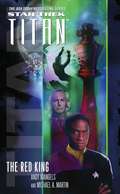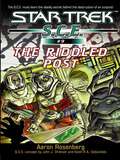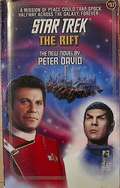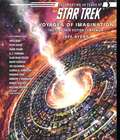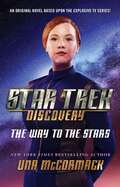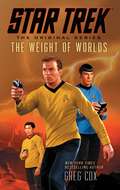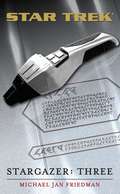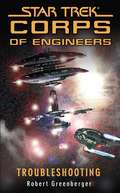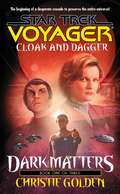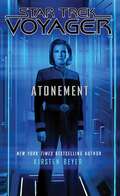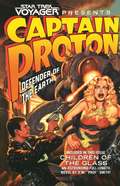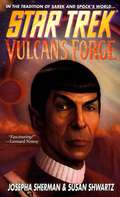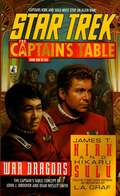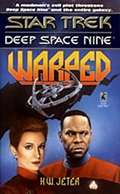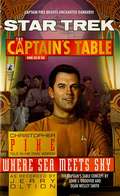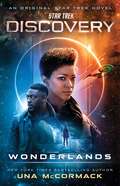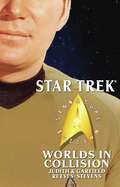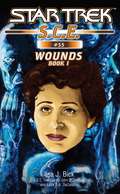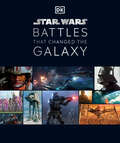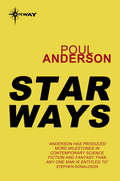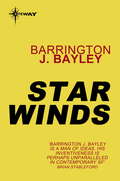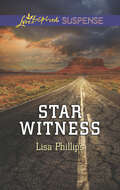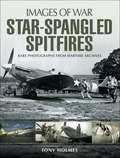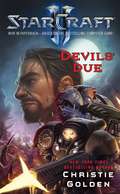- Table View
- List View
Star Trek: The Red king (Star Trek: The Next Generation)
by Andy Mangels Michael A. MartinInvestigating the disappearance of a secret Romulan fleet, the U.S.S. Titan, commanded by Captain William Riker, is unexpectedly propelled more than 200,000 light-years into the Small Magellanic Cloud. One of the Milky Way's satellite galaxies, the Cloud is also home to the Neyel, the long-sundered offshoots of Terran humanity, with whom the Federation has had no contact in over eighty years. Nearby, Riker's uncertain ally, Commander Donatra of the Romulan Warbird Valdore, rescues a young Neyel, the survivor of a mysterious cosmic upheaval that seems at times to be both unraveling and reweaving the very fabric of space...the fulfillment of an apocalyptic vision that has already claimed millions of lives. Titan's science team soon finds evidence that the ravaging of Neyel space is the work of a vast and powerful intelligence: the stirrings of a dormant consciousness that is maintaining the existence of the Small Magellanic Cloud -- and all life within it -- from one moment to the next. And if it should awaken, the consequences are unimaginable. As Riker considers his options, his new crew struggles with the scientific and philosophical implications of what they've discovered...while the young Neyel in their midst forges a bond with the captain, conjuring old ghosts Riker has yet to lay to rest.
Star Trek: The Riddled Post
by Aaron RosenbergSTARFLEET CORPS OF ENGINEERS The dilithium mining outpost on BorSitu Minor is an understaffed, uninteresting, unspectacular place full of miners, engineers, and scientists who have never done harm to anyone, nor do they have anything of value. Yet the outpost has been devastated by a brutal assault, with almost all hands lost -- and the survivors have no idea what attacked them. Worse, the attack weapon appears to have the power to penetrate the outpost's powerful shields. That has the crew of the U.S.S. da Vinci worried, as it could just as easily destroy a starship! Now the S.C.E. team, led by Commander Sonya Gomez, must find out the truth behind what ravaged the outpost, and hope that someone hasn't unleashed a weapon that could destroy them all!
Star Trek: The Rift
by Peter DavidEvery thirty-three years, a rift in space connects the Federation with a mysterious race called the Calligar who live on a planet hundreds of light years away -- much too far to travel in a Starship. Captain Kirk and the U.S.S. Enterprise are dispatched to transport a Federation delegation of diplomats, scholars and scientists who will travel to Calligar directly during the brief period of time that the rift will be open. Mr. Spock leads the Federation party as they travel by shuttle through the rift just as a group of the aliens arrive in Federation space. The meetings go smoothly until the Calligar take Spock's party hostage and Kirk discovers that the aliens are keeping a deadly secret. With angry Tellarite and Andorain fleets ready to attack the Calligar, Kirk must save Spock and the others before war breaks out and the rift closes for another fifty years.
Star Trek: The Star Trek Fiction Companion
by Jeff AyersThrough four decades, five television series comprising over seven hundred episodes, ten feature films, and an animated series, fandom's thirst for more Star Trek stories has been unquenchable. From the earliest short-story adaptations by James Blish in the 1960s, followed by the first original Star Trek novels during the seventies, and on throughout the eighties, nineties, and into the twenty-first century, fiction has offered an unparalleled expansion of the rich Star Trek tapestry. But what is it that makes these books such a powerfully attractive creative outlet to some and a compelling way to experience the Star Trek mythos anew to others? Voyages of Imagination takes a look back on the first forty years of professionally published Star Trek fiction, revealing the personalities and sensibilities of many of the novels' imaginative contributors and offering an unprecedented glimpse into the creative processes, the growing pains, the risks, the innovations, the missteps, and the great strides taken in the books. Author Jeff Ayers has immersed himself in nearly six hundred books and interviewed more than three hundred authors and editors in order to compile this definitive guide to the history and evolution of an incomparable publishing phenomenon. Fully illustrated with the covers of every book included herein, Voyages of Imagination is indexed by title and author, features a comprehensive timeline, and is a must-have for every fan.
Star Trek: The Way to the Stars (Star Trek: Discovery #4)
by Una McCormackAn original novel based on the explosive TV series Star Trek: Discovery!Despite being an inexperienced Starfleet cadet, Sylvia Tilly became essential to the USS Discovery finding its way back home from the Mirror Universe. But how did she find that courage? From where did she get that steel? Who nurtured that spark of brilliance? The Way to the Stars recounts for fans everywhere the untold story of Tilly&’s past. It&’s not easy being sixteen, especially when everyone expects great things from Tilly. It&’s even harder when her mother and father are Federation luminaries, not to mention pressing her to attend one of the best schools that the Federation has to offer. Tilly wants to achieve great things—even though she hasn&’t quite worked out how to do that or what it is she wants to do. But this year, everything will change for Tilly, as she about to embark upon the adventure of a lifetime—an adventure that will take her ever closer to the stars…
Star Trek: The Weight of Worlds (Star Trek: The Original Series)
by Greg CoxThe Ephrata Institute is an intellectual think tank at the outer fringes of the final frontier. Dedicated to the arts and sciences, the Institute seems an unlikely target for an invasion, but it proves easy pickings when the Crusade comes from beyond, determined to impose its harsh, unbending Truth on all the worlds of the Federation. Armed with weaponized gravity, the alien Crusaders will stop at nothing to rescue the universe from its myriad beliefs . . . even if it means warping the mind and soul of every sentient being they encounter. Responding to an urgent distress signal, Captain James T. Kirk and the crew of the U.S.S. Enterprise soon find themselves in conflict with the Crusade, and facing individual challenges. When Kirk and Spock are transported to the Crusade's distant homeland to confront the source of the invasion, Sulu finds himself trapped behind enemy lines, while Lieutenant Uhura is faced with possibly the most difficult decisions of her career. As the Crusade sets its sights beyond Ephrata IV, it is up to the Enterprise and its besieged crew to keep freedom of thought from being crushed beneath the weight of worlds!
Star Trek: Three (Star Trek: The Next Generation #3)
by Michael Jan FriedmanA rift in the Mirror Universe threats the crew of the Stargazer in this Star Trek: The Next Generation novel.Identical twins Gerda and Idun Asmund lost their human parents early in life and were raised as warriors on the Klingon homeworld. They were taught to face every danger shoulder to shoulder—regarding each other as the only certainty in a dangerous and uncertain universe. The Asmunds continued to depend on each other as helm officer and navigator on the Starship Stargazer, peril and adversity forging a bond between them as strong as tritanium. But that bond is tested when a transporter mishap deposits a mysterious visitor on the Stargazer—a beautiful woman from another universe who resembles Gerda and Idun as closely as they resemble each other. As Captain Jean-Luc Picard pits the Stargazer against a savage alien species in a gallant attempt to send their visitor home, Gerda comes to suspect the woman of treachery. But she has to wonder—is she following her Klingon instincts or succumbing to simple jealousy? Gerda needs to find out—before Picard and his crew pay for their generosity with their lives.
Star Trek: Troubleshooting (Star Trek: Starfleet Corps of Engineers)
by Robert GreenbergerRelaunching the adventures of the U.S.S. da Vinci, as Captain David Gold, Commander Sonya Gomez, and the rest of Starfleet's miracle workers solve the problems of the galaxy, one disaster at a time. Federation Station Deep Space 10 has been plagued by technical difficulties since its construction a year ago. On several occasions, the Starfleet Corps of Engineers team on the da Vinci has been sent to fix them, and now the problems have intensified. Fearing sabotage or worse, Commander Gomez and her team try to fix the station once and for all -- but Dr. Sarjenka has another idea about what's happening, a theory that puts her at odds with her new superior officer, Dr. Lense. Continuing the all-new adventures of the S.C.E.!
Star Trek: Voyager (Cloak and Dagger #1)
by Christie GoldenCloak and Dagger: Dark Matters #1 It is a scientific truth that the structure of the universe depends on the amount of "dark matter" contained in the cosmos. When sinister forces threaten to tamper with the very nature of reality, Captain Janeway and the crew of the U.S.S. Voyager must risk everything to restore the universal balance.... Years ago, near the beginning of its long journey, Voyager made contact with a brilliant Romulan scientist whose present was Voyager 's past. Now Telek R'Mor communicates with Janeway again -- to warn her of a dire plot to capture Voyager and turn its "future" technology against the Federation of yesterday. But more than just the timeline is at stake. Voyager itself may be carrying a menace deadly to all creation!
Star Trek: Voyager Atonement (Star Trek: Voyager)
by Kirsten BeyerAn original novel set in the universe of Star Trek: Voyager--and the sequel to Protectors and Acts of Contrition!Admiral Kathryn Janeway faces a tribunal determined to execute her for supposed crimes committed during Voyager's maiden trek through the Delta Quadrant. Captain Chakotay knows that the Kinara, several species now allied against the Full Circle fleet, are not all they appear to be. The Confederacy of the Worlds of the First Quadrant--a pact he cannot trust--is his only hope for unraveling the Kinara's true agenda and rescuing Admiral Janeway. Meanwhile, Seven and Tom Paris are forced to betray the trust of their superiors in a desperate bid to reveal the lengths to which a fellow officer has gone in the name of protecting the Federation from the legendary Caeliar. TM, ®, & © 2015 CBS Studios, Inc. STAR TREK and related marks are trademarks of CBS Studios, Inc. All Rights Reserved.
Star Trek: Voyager: Captain Proton: Defender of the Earth (Star Trek: Voyager #7)
by Dean Wesley SmithReturn with us now to those thrilling days of yesteryear when Real Men with ray guns and beautiful women in beguiling outfits battled hideous monsters from outer space! Return with us to the days when Captain Proton ruled the skyways! When the queen of an evil space empire kidnaps Captain Proton's faithful secretary Constance Goodheart, it's only the first step in her diabolical plan to conquer the Incorporated Planets. It soon becomes clear that there is more to her plot than meets the eye when, on the very edge of death, Captain Proton is saved by a power Not Of This Universe. Caught in an eons-old fight between two alien races, who can Captain Proton trust? No one -- not even his sidekick, ace reporter Buster Kincaid. Can Captain Proton save the Galaxy from the forces of evil and save Constance Goodheart from the Giant Demon Squid of Greyhawk II? Extra! Dr. Chaotica plots the Death of the Patrol, Constance Goodheart must find Captain Proton before she shrinks to a size too small to be seen, and Buster Kincaid faces the Swamp of Doom!
Star Trek: Vulcan's Forge (Star Trek: The Original Series)
by Josepha Sherman Susan ShwartzJust over a year ago, Captain James T. Kirk was lost to the Nexus while saving the U.S.S. Enterprise 1701-B from destruction. Aboard the science ship Intrepid II, Captain Spock, commanding some of his old crewmates, must face the loss of his closest friend. But while still in mourning for one friend, he must come to the aid of another. Decades ago, Spock had teamed up with David Rabin, the young son of a Starfleet Captain, to fight an attempted coup on Vulcan that would have turned the planet's people away from the path of logic. Now a Starfleet officer, Captain David Rabin has been assigned to a harsh desert world much like Vulcan, where the Federation is determined to protect the lives of the inhabitants. But Rabin's efforts are being sabotaged and he has asked for Spock's help against the unknown forces that may well destroy the society he had come to save. While reflecting on his youthful adventure with David Rabin, Spock joins with Rabin to face and enemy out of their past and confront deadly Romulan treachery. In the process Spock will decide if the path of his life now leads back toward the family traditions he had once sought to escape.
Star Trek: War Dragons (Star Trek: The Original Series)
by L.A. GrafThere's a bar called "The Captain's Table," where those who have commanded mighty vessels of every shape and era can meet, relax, and share a friendly drink or two with others of their calling. Sometimes a brawl may break out but it's all in the family, more or less. Just remember, the first round of drinks is always paid for with a story...even beyond the final frontier.Captain James T. Kirk must join forces with Captain Hikaru Sulu, new commander of the U.S.S. Excelsior, to resolve a simmering political situation in a distant star system. For more than twenty years, the ancient enmity between Nykkus and Anjiri has resisted the best efforts of Federation diplomats. Now Kirk and Sulu have one last chance to end the bloodshed -- before it erupts into a full-scale interstellar war!
Star Trek: Warped (Star Trek: Deep Space Nine)
by K.W. JeterPolitical tensions on Bajor are once again on the rise, and the various factions may soon come to open conflict. In addition, a series of murders has shaken everyone on board the station. While Security Chief Odo investigates the murders, Commander Sisko finds himself butting up against a new religious faction that plans to take over Bajor and force the Federation to leave Deep Space Nine. Odo soon traces the murders to a bizarre and dangerous form of holosuite technology--a technology that turns it's users into insane killers and now threatens Sisko's son, Jake. As the situation on Bajor deteriorates, Sisko learns that the political conflict and the new holosuites are connected. Both are the work of a single dangerous man with a plan that threatens the very fabric of reality. The plot is darker than anything Sisko has faced before, and to defeat it, he must enter the heart of a twisted, evil world where danger lurks in every corner and death can come at any moment--from the evil within himself, from his closest friends, or even at the hands of his own son.
Star Trek: Where Sea Meets Sky (Star Trek: Enterprise)
by Jerry OltionThere's a bar called "The Captain's Table," where those who have commanded mighty vessels of every shape and era can meet, relax, and share a friendly drink or two with others of their calling. Sometimes a brawl may break out but it's all in the family, more or less. Just remember, the first round of drinks is always paid for with a story...fishy or not.Years before Kirk took command, Captain Christopher Pike guided the Starship Enterprise on a five-year mission. Pike's journey took him to many new and unexplored realms, none more strange or perilous than a devastated star system where huge, space-faring lifeforms, vital to the survival of one inhabited star system, wreak havoc on the humanoid inhabitants of the other. Captain Pike must thrust the Enterprise into deadly danger as he fights to save one innocent civilization without dooming the other.
Star Trek: Wonderlands (Star Trek: Discovery #8)
by Una McCormackAn all-new novel based upon the explosive Star Trek TV series! In a desperate attempt to prevent the artificial intelligence known as Control from seizing crucial information that could destroy all sentient life, Commander Michael Burnham donned the &“Red Angel&” time-travel suit and guided the USS Discovery into the future and out of harm&’s way. But something has gone terribly wrong, and Burnham has somehow arrived in a place far different from anything she could have imagined—more than nine hundred years out of her time, with Discovery nowhere to be found, and where the mysterious and cataclysmic event known as &“the Burn&” has utterly decimated Starfleet and, with it, the United Federation of Planets. How then can she possibly exist day-to-day in this strange place? What worlds are out there waiting to be discovered? Do any remnants of Starfleet and the Federation possibly endure? With more questions than answers, Burnham must nevertheless forge new friendships and new alliances if she hopes to survive this future long enough for the Discovery crew to find her.... ™, ®, & © 2021 CBS Studios, Inc. STAR TREK and related marks and logos are trademarks of CBS Studios, Inc. All Rights Reserved.
Star Trek: Worlds in Collision (Star Trek: The Original Series)
by Judith Reeves-StevensOf all the experiences shared by Captain Kirk and the crew of the Starship Enterprise during their first five-year mission, two were among the most perilous: a journey to the nonphysical realm of Transition where the massive computer known as Memory Prime was situated, and the nightmarish mission to Talin IV, a world poised on the brink of destruction that Kirk was forbidden to save. In the twenty-third century, a hundred years before a sentient artificial life-form would be allowed to earn a Starfleet commission, the Federation considers the use of self-aware artificial intelligences to be little more than slavery, except for the immense computer system of Memory Prime -- the key hub in the Federation's vast network of interstellar library planets. There, the A.I.s known as Pathfinders inhabit Transition -- a virtual world so different from our universe that the A.I.s themselves debate whether or not the physical universe is real. But when an ancient enemy reaches out from the shadows of Vulcan's darkest history and threatens to destroy the Federation, Spock must risk his career, and his life, to enter the Pathfinders' realm. Technologically and politically, Talin IV is little different from late-twentieth century Earth. But as a series of mysterious events pushes that world closer to self-annihilation, the Prime Directive prevents Captain Kirk and his crew from doing anything to prevent it. When the worst appears to happen and Kirk takes desperate action to give the Talin a chance to step back from the nuclear abyss, Talin IV is consumed by radioactive fire. Now, with a world destroyed and the Enterprise dead in space, the careers of Kirk and his crew are over. Disgraced and despised, Kirk has only one chance to redeem himself and his crew: Somehow, he must make his way back to Talin IV and discover what really happened, even if it means proving that a world died because he broke Starfleet's most sacred law. Bonus: An Exclusive Interview with the Authors
Star Trek: Wounds, Book 1
by Ilsa J. BickWhile traveling to a medical conference, the Runabout Missouri encounters a strange anomaly that sends the runabout crashing to the surface of an unknown planet, leaving its two passengers -- Dr. Elizabeth Lense of the U.S.S. da Vinci and Dr. Julian Bashir of Deep Space 9 -- separated. Each physician thinks the other dead, and each winds up trapped with the factions of a decades-old conflict between those who want to replace dying limbs with cybernetics, and those who want to remain pure. Trapped with no hope of rescue, both Lense and Bashir must find their way on a primitive world -- or die....
Star Wars Battles that Changed the Galaxy
by Jason Fry Chris Kempshall Amy Ratcliffe Cole HortonExplore the &“Wars&” in Star Wars as never before!Enter a galaxy ravaged by conflict and discover the complete story of the epic struggles that define the Star Wars movies. This ambitious book presents major galactic conflicts from an in-world &“historical&” perspective: each battle is depicted with captivating imagery, explored with newly commissioned maps, and explained through a detailed analysis of tactics, famous commanders, legendary warriors, key moments, and its impact on wider galactic history. This is the perfect book for any Star Wars fan, budding military historian, or would-be rebel hero! © AND TM 2021 LUCASFILM LTD.
Star Ways: Psychotechnic League Book 1 (PSYCHOTECHNIC LEAGUE)
by Poul Anderson"Five of our worlds are missing". That was the essence of the report that shocked the galactic Nomads at their annual meeting. For each of the mighty star-ships reported vanished was a world of its own - a man-made, self-sustaining city-state housing thousands of people. The Nomads themselves were an unplanned by-product of man's conquest of the stars. They were the gypsies of the distant future, the restless rovers of outer space. But to Joachim of the peregrine tey represented a way of life that was to be dearly defended. So it fell to him to make his own world-ship the bait in a cosmic trap set to catch the galaxy's unknown foemen!
Star Winds
by Barrington J. BayleyThe sails were the product of the Old Technology, lost long ago in the depleted Earth, and they were priceless. For with those fantastic sheets of etheric material, ships could sail the sky and even brave the radiant tides between worlds and stars.The alchemists who had replaced scientists still sough the ancient secrets, and Rachad, apprentice to such a would-be wizard, learned that the key to his quest lay in a book abandoned in a Martian colonial ruin long, long ago.But how to get to Mars? There was one way left - take a sea vessel, caulk it airtight, steal new sails and fly the star winds in the way of the ancient windjammers.Here is an intriguing, unusual and colourful novel of ships that sail the stars riding before the solar breeze that blows between worlds.
Star Witness
by Lisa PhillipsShe thought she was safe . . . A singer and a soldier share faith and danger in this pulse-pounding romantic thriller from the USA Today–bestselling author.Mackenzie Winters spent years building a life in Witness Protection, but when someone shoots at her, she fears her cover has been blown. Could the brother of the drug lord she put away be here for revenge? Mackenzie must rely on her handler’s twin, world-weary Delta Force soldier Aaron Hanning, to protect her. Aaron doesn’t want to be anyone’s hero, but he can’t let this brave woman die. Now, with danger stalking them, they’ll have to make a daring choice that means life or death—for them both.“Phillips’ sophomore effort for LIS is engaging from early on. The developing relationship does not detract from the increasing suspense. Mackenzie demonstrates that it is perfectly fine to ask for and accept forgiveness.” —RT Book Reviews
Star-Spangled Spitfires (Images of War)
by Tony HolmesThrough the medium of period photography, Star-Spangled Spitfires chronicles the combat operations of the USAAF units equipped with the iconic Supermarine fighter whilst employed in both the European and Mediterranean theaters of war, from the summer of 1942 right up to the end of the conflict.Only a handful of British combat aircraft wore the stars and bars of the USAAF during the Second World War, with the Beaufighter, Mosquito and Spitfire being the key types to see action with American crews in American squadrons. The Spitfire was, by some margin, the most widely used of the three, and the Yanks that flew it in combat rated the fighter very highly. Employed primarily by the six squadrons of the 31st and 52nd Fighter Groups, initially from airfields in the UK and then in North Africa and Italy, the Spitfire was used both as a fighter and fighter-bomber until it was replaced by the P-51 Mustang from the spring of 1944.The final star-spangled Spitfires in the frontline were the Eighth Air Forces high-flying and unarmed PR XI photo-reconnaissance aircraft, flown by to the 7th Photographic Reconnaissance Group alongside F-5 Lightnings from November 1943. Ranging as far into Germany as Berlin, the PR Blue Spitfires provided critical target imagery both pre- and post-strike for the Mighty Eighths heavy bombardment groups through to April 1945.All feature here across a series of black and white and color images that all capture some unique aspect of the star-spangled Spitfire's illustrious service career.
StarCraft II: Devils'
by Christie GoldenIt was at times like this that Jim Raynor, former marine lance corporal, proud citizen of the Confederacy and erstwhile farm boy, felt most alive. At the speed at which he was urging the vulture, the wind cooled his face so that the oppressive heat vanished. He felt like a wolf hunting down prey, except the purpose of today's adventure was not the death of a living being but the death of the empty state of Raynor's and Tychus's wallets. This was a cargo train, not a passenger train, and inside its silvery innards was--if Tychus's tip was right, and Jim had every reason to believe it would be--a very lovely, very large safe filled with Confederate credits. "Why, it's a rescue mission, Jim," Tychus had rumbled, his blue eyes dancing with good humor as he had filled Raynor in on the plan. "Those poor creds--they'd just be condemned to lining the pockets of some Old Families who don't need any more money. Or else put to some nefarious scheme that could hurt somebody. It's our duty--hell, it's our calling--to liberate them creds to where they could do something that really mattered." "Like buying us drinks, women, and steak dinners." "That's a good start." "You've got a heart of gold, Tychus. I've never met such an altruistic man in my life. I got goddamn tears in my eyes." "It's a tough job, but somebody's got to do it." Jim grinned as he recalled the conversation. He and Tychus were behind the train, catching up to it quickly. He stayed right and Tychus veered left. Tychus crossed over the maglev tracks, adjusting the magnetic frequency on his bike to compensate so that he, like the train itself, could cross easily. Jim increased his speed, moving alongside the maglev until the right car came into view. He and Tychus had spent hours analyzing all kinds of transportation vessels over the last few years, sometimes simply from blueprints or images, but usually up close and personal, as they were about to do now. They had "liberated" other credits before--it seemed to them like hundreds of thousands over the years, although the liberated credits never seemed to stay with them very long. That was all right too. It was part of the ride that life had become. *** The year is 2494. Almost five years ago, Jim Raynor and Tychus Findlay were members of the Heaven's Devils, an elite Confederate marine unit praised for its nerves of steeland combat expertise. After making a stand against their corrupt commanding officer, the two men were forced to go AWOL or risk being unjustly prosecuted and resocialized. Now, Raynor and Findlay are outlaws hounded by an unyielding interstellar marshal. Life, however, has never beenbetter. Each day is another chance to pilfer more credits from the Confederacy's deep coffers. Each night holds the promise of spending their hard-earned profits in bars, brothels, and gambling halls. But a man can only run so far before the law--and his past--catch up with him. . . . Devils' Due recounts an unforgettable period of Jim Raynor's life as he descends into the Koprulu sector's criminal underworld alongside the street-savvy Findlay. Here, far from his humble upbringing on the fringe world of Shiloh, Raynor will face some of the most trying challenges of his life. The decisions he makes will alter his destiny forever and put his father's oft-spoken wisdom, "A man is what he chooses to be," to the ultimate test.
StarCraft II: Devils' Due
by Christie GoldenIt was at times like this that Jim Raynor, former marine lance corporal, proud citizen of the Confederacy and erstwhile farm boy, felt most alive. At the speed at which he was urging the vulture, the wind cooled his face so that the oppressive heat vanished. He felt like a wolf hunting down prey, except the purpose of today's adventure was not the death of a living being but the death of the empty state of Raynor's and Tychus's wallets. This was a cargo train, not a passenger train, and inside its silvery innards was--if Tychus's tip was right, and Jim had every reason to believe it would be--a very lovely, very large safe filled with Confederate credits. "Why, it's a rescue mission, Jim," Tychus had rumbled, his blue eyes dancing with good humor as he had filled Raynor in on the plan. "Those poor creds--they'd just be condemned to lining the pockets of some Old Families who don't need any more money. Or else put to some nefarious scheme that could hurt somebody. It's our duty--hell, it's our calling--to liberate them creds to where they could do something that really mattered." "Like buying us drinks, women, and steak dinners." "That's a good start." "You've got a heart of gold, Tychus. I've never met such an altruistic man in my life. I got goddamn tears in my eyes." "It's a tough job, but somebody's got to do it." Jim grinned as he recalled the conversation. He and Tychus were behind the train, catching up to it quickly. He stayed right and Tychus veered left. Tychus crossed over the maglev tracks, adjusting the magnetic frequency on his bike to compensate so that he, like the train itself, could cross easily. Jim increased his speed, moving alongside the maglev until the right car came into view. He and Tychus had spent hours analyzing all kinds of transportation vessels over the last few years, sometimes simply from blueprints or images, but usually up close and personal, as they were about to do now. They had "liberated" other credits before--it seemed to them like hundreds of thousands over the years, although the liberated credits never seemed to stay with them very long. That was all right too. It was part of the ride that life had become. *** The year is 2494. Almost five years ago, Jim Raynor and Tychus Findlay were members of the Heaven's Devils, an elite Confederate marine unit praised for its nerves of steeland combat expertise. After making a stand against their corrupt commanding officer, the two men were forced to go AWOL or risk being unjustly prosecuted and resocialized. Now, Raynor and Findlay are outlaws hounded by an unyielding interstellar marshal. Life, however, has never beenbetter. Each day is another chance to pilfer more credits from the Confederacy's deep coffers. Each night holds the promise of spending their hard-earned profits in bars, brothels, and gambling halls. But a man can only run so far before the law--and his past--catch up with him. . . . Devils' Due recounts an unforgettable period of Jim Raynor's life as he descends into the Koprulu sector's criminal underworld alongside the street-savvy Findlay. Here, far from his humble upbringing on the fringe world of Shiloh, Raynor will face some of the most trying challenges of his life. The decisions he makes will alter his destiny forever and put his father's oft-spoken wisdom, "A man is what he chooses to be," to the ultimate test.
